|
 Russula griseoviridis Russula griseoviridis
BiostatusPresent in region - Indigenous. Endemic
Images (click to enlarge)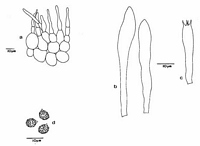
Caption: Fig. 16 - Russula griseoviridis: a, cuticle; b, pleurocystidia; c, basidium; d, spores. | 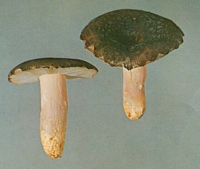
Caption: Fig. 35 - Russula griseoviridis (x 3/4) | 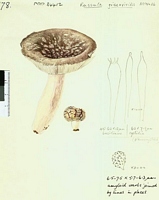
Caption: Watercolour
Owner: G.M. Taylor | 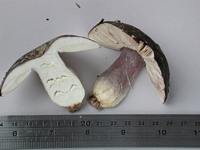
Caption: fruitbody
Owner: J.A. Cooper | 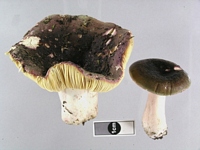
Owner: J.A. Cooper | 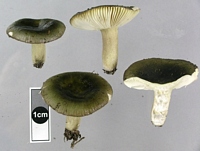
Owner: J.A. Cooper | 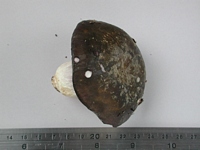
Caption: fruitbody
Owner: J.A. Cooper | 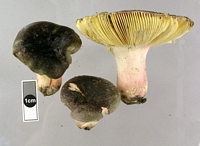
Owner: J.A. Cooper | 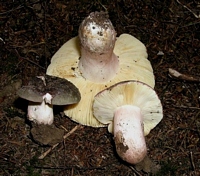
Owner: J.A. Cooper | 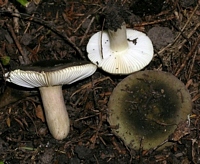
Owner: J.A. Cooper | 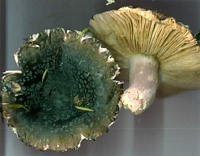
Owner: P. Leonard | 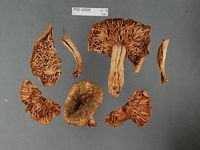
Caption: Dried type specimen
Owner: Herb PDD | 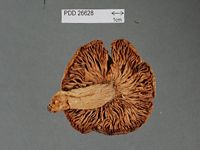
Caption: Dried type specimen
Owner: Herb PDD |
Article: McNabb, R.F.R. (1973). Russulaceae of New Zealand. 2. Russula Pers. ex S.F. Gray. New Zealand Journal of Botany 11(4): 673-730 (http://www.rsnz.org/publish/abstracts.php).
Description: pileus: 5-10.5 cm diam., hemispherical to convex
when young, centrally depressed to shallow-infundibuliform at maturity, viscid,
early creviced with areolate patches crowded in centre and becoming less numerous
and scattered towards margins, ground colour dull green, greyish green, or pallid
olive, often tinged with greyish red under dry conditions, areolae pallid greyish
green, margins often radially split at maturity, thin, slightly involute, non-pectinate
or faintly pectinate under dry conditions in old specimens. Cuticle readily
separable, 250-300 µm thick, consisting of distinct epicutis and sub-cutis;
epicutis composed of erect, aseptate or septate, filamentous, ciliate, or papillate
elements to 50 µm, long, arising from a layer of sphaerocysts 4-8 cells deep;
sub-cutis heavily gelatinised composed of interwoven, thin-walled, septate hyphae
1.5-4 µm diam., repent or obliquely ascending, oleiferous hyphae occasionally
present. lamellae: free to adnexed, crowded, moderately thick, simple or occasionally
forked near stipe, to 7 mm deep, white to pallid creamy white, not discoloured
at maturity, lamellulae rare. stipe: 2-7 cm long, ± equal, 1.2-2.8 cm diam.,
solid or chambered at maturity, dry, finely velutinate under lens, pallid smoke
grey, pallid rose-grey, or pallid grey with faint purplish tints, rarely white;
flesh white, unchanging on exposure to air. Cuticle composed of interwoven hyphae
2.5-4 ^m diam., terminal cells projecting obliquely or at right angles to surface.
spores: spore print white; spores broadly elliptical,
obliquely apiculate, apiculus to 1.5 µm, long, 7-9 X 6-7 µm, ornamentation of
fine amyloid verrucae to 0.5-(0.8) µm, high, joined by fine to moderately fine
amyloid ridges and forming an incomplete reticulum, or occasionally isolated:
plage indistinct. hymenium: basidia
clavate, hyaline, 35-53 X 6.5-11 µm, 4-spored, sterigmata to 6 µm long; pleurocystidia
scattered, sparse, broadly fusiform or subclavate, hyaline, thin-walled, contents
sparse, refractive in KOH, projecting to 20 µm, beyond basidia at times, apices
acuminate, bluntly acuminate or capitulate, 63-87 X 7.5-14 µm, cheilo-cystidia
sparse, similar to pleurocystidia but shorter, intermixed with numerous filamentous
or subclavate, septate structures to 4 µm diam. hymenophoral
trama: heteromerous, intermixed, numerous oleiferous
hyphae present. context of pileus:
white, unchanging; structure heteromerous, clamp connections absent.
taste: lamellae and context mild, chemical characters:
formalin on context—n.r.; phenol on context—slowly deep vinaceous; FeSO4
on context—rapidly salmon pink: guaiacol on stipe base—rapidly faint pink, finally
pinkish red: KOH and NH4OH on pileus and context-—n.r.
Habitat: Solitary or scattered under Leptospermum.
Notes: The distinctive
cuticular structure indicates that R. griseoviridis belongs in section
Rigidae Fr. subsection Virescentinae Sing. as defined by Singer
(1962). The epicutis of young fructifications soon ruptures forming areolate
patches seated on the continuous subcutis. These epicuticular patches resemble
velar remnants.
|